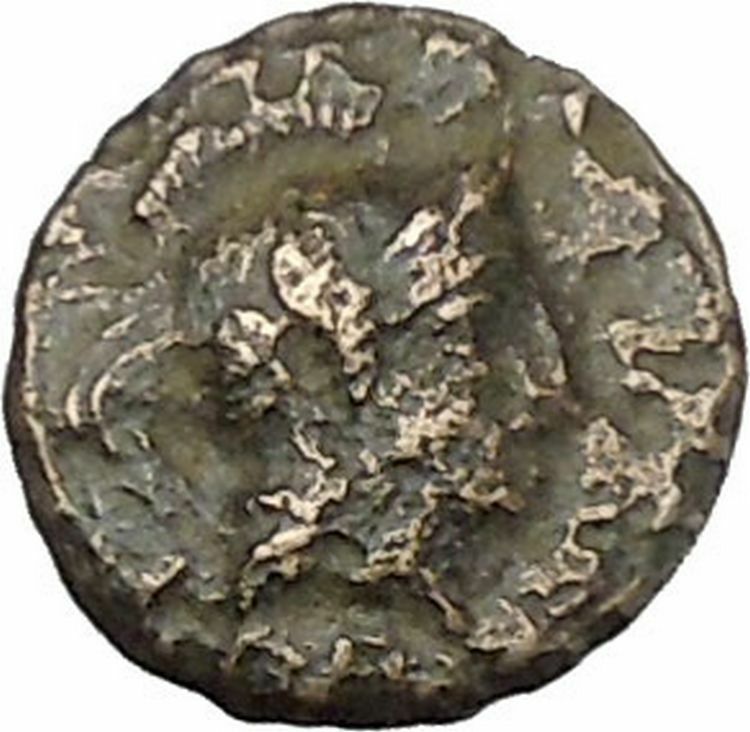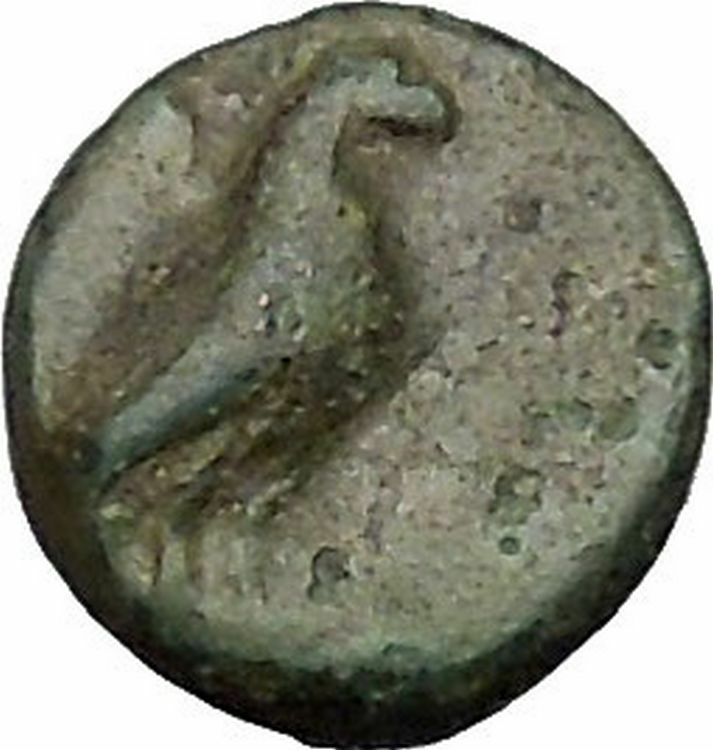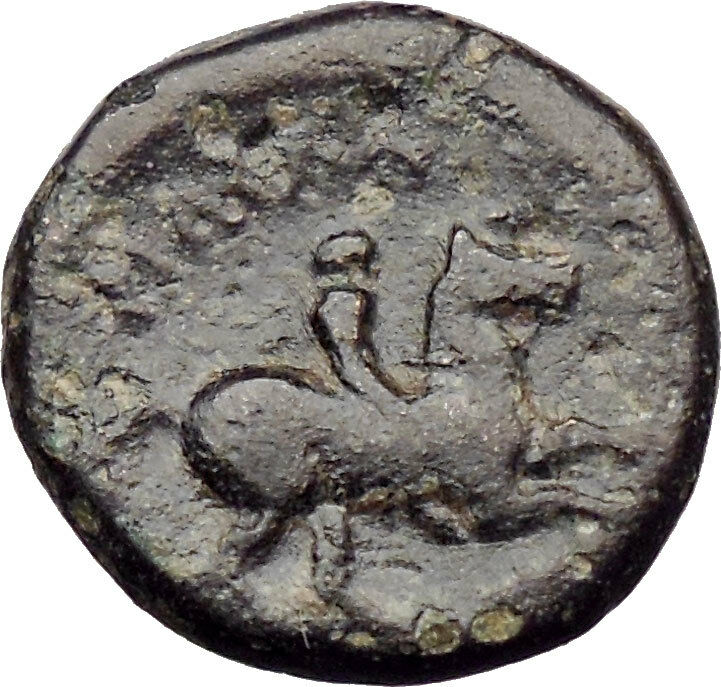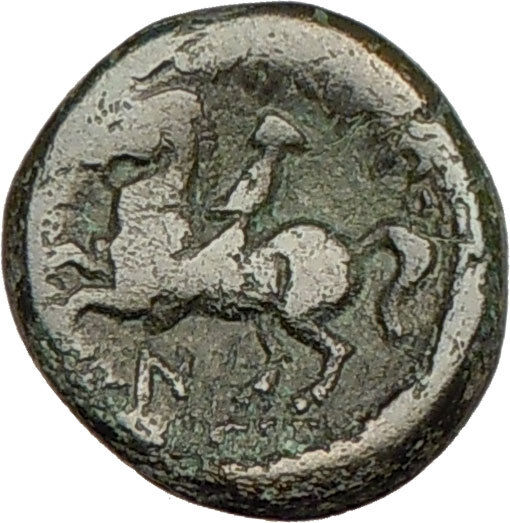|
Seleucid Kingdom
Antiochus IX Cyzicenus – King:
113-96 B.C. –
Bronze 19mm (4.70 grams) Struck 112-111 B.C.
Reference: Sear 7173; SNG Israel 2743; BMC 4.94,27
Winged bust of Eros right.
Nike advancing left, holding wreath; on right ΒΑΣΙΛΕΩΣ / ΑΝΤΙΟΧΟΥ;
on left, ΦΙΛΟΠΑΤOΡΟΣ;
in field
to left, Seleucid date.
You are bidding on the exact item pictured,
provided with a Certificate of Authenticity and Lifetime Guarantee of
Authenticity.
In
Greek mythology
,
Nike
was a goddess
who personified
victory
, also known as the Winged Goddess of
Victory. The Roman equivalent was
Victoria
. Depending upon the time of various
myths, she was described as the daughter of
Pallas
(Titan) and
Styx (Water) and the sister of
Kratos
(Strength),
Bia
(Force), and
Zelus
(Zeal). Nike and her siblings were close
companions of Zeus
, the dominant deity of the
Greek pantheon
. According to classical (later)
myth, Styx brought them to Zeus when

the
god was assembling allies for the
Titan War
against the older deities. Nike
assumed the role of the divine
charioteer
, a role in which she often is
portrayed in Classical Greek art. Nike flew around battlefields rewarding the
victors with glory and fame.
Nike is seen with wings in most statues and paintings. Most other winged
deities in the Greek pantheon had shed their wings by Classical times. Nike is
the goddess of strength, speed, and victory. Nike was a very close acquaintance
of Athena
, and is thought to have stood in
Athena’s outstretched hand in the statue of Athena located in the Parthenon.
Nike is one of the most commonly portrayed figures on Greek coins.
Names stemming from Nike include amongst others:
Nicholas
, Nicola, Nick, Nikolai, Nils, Klaas,
Nicole, Ike, Niki, Nikita, Nika, Niketas, and Nico.
![Eros1st c. BCE marble from Pompeii. This statue is also known as Eros Centocelle, and is thought to be a copy of the colossal Eros of Thespiae, a work by Praxiteles.[1]](https://upload.wikimedia.org/wikipedia/commons/thumb/c/c3/Eros_Farnese_MAN_Napoli_6353.jpg/150px-Eros_Farnese_MAN_Napoli_6353.jpg) Antiochus Antiochus
IX Cyzikenes, ruler of the
Greek
Seleucid kingdom
, was the son of
Antiochus VII Sidetes
and
Cleopatra Thea
. Upon the death of his father in
Parthia
and his uncle
Demetrius II Nicator’s
return to power (129
BC), his mother sent him to
Cyzicus
on the
Bosporus
, thus giving him his nickname. He
returned to Syria
in 116 BC to claim the
Seleucid
throne from half-brother/cousin
Antiochus VIII Grypus
, with whom he eventually
divided Syria. He was killed in battle by the son of Grypus,
Seleucus VI Epiphanes
in 96 BC.
Eros, in
Greek mythology
, was the
primordial god
of sexual love and beauty. He was also worshipped as a
fertility deity. His
Roman
counterpart was
Cupid
(“desire”),
also known as Amor (“love”). In some myths, he was the son of the deities
Aphrodite
and Ares
, but
according to Plato’s
Symposium
, he was conceived by Poros (Plenty) and Penia (Poverty) at
Aphrodite’s birthday. Like
Dionysus
,
he was sometimes referred to as Eleutherios, “the liberator”.
Conception
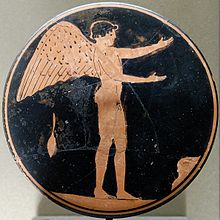
Eros depicted on an
Attic red-figure
bobbin (ca.
470–450 BC)
Throughout Greek thought, there appear to be two sides to the conception of
Eros. In the first, he is a primeval deity who embodies not only the force of
love but also the creative urge of ever-flowing nature, the firstborn Light for
the coming into being and ordering of all things in the cosmos. In
Hesiod’s
Theogony
, the most famous Greek
creation myth
, Eros sprang forth from the
primordial
Chaos
together with
Gaia
, the Earth, and
Tartarus
, the
underworld
; according to
Aristophanes
‘ play
The Birds
(c. 414 BC), he burgeons forth
from an egg laid by Nyx
(Night) conceived with
Erebus
(Darkness). In the
Eleusinian Mysteries
, he was worshiped as
Protogonus
, the first-born.
Worship of Eros was uncommon in early Greece, but eventually became
widespread. He was fervently worshiped by a fertility cult in
Thespiae
, and played an important role in the
Eleusinian Mysteries
. In
Athens
, he shared a very popular cult with
Aphrodite, and the fourth day of every month was sacred to him.
Eros and Psyche
The story of Eros and Psyche has a longstanding tradition as a folktale of
the ancient Greco-Roman world long before it was committed to literature in
Apuleius
‘
Latin
novel,
The Golden Ass
, this is apparent and an
interesting intermingling of character roles. The novel itself is picaresque
Roman style, yet Psyche and Aphrodite retain their Greek parts. It is only Eros
whose role hails from his part in the Roman pantheon.The story is told as a
digression and structural parallel to the main storyline of Apuleius’ novel. It
tells of the struggle for love and trust between Eros and Psyche. Aphrodite is
jealous of the beauty of mortal Psyche, as men are leaving her altars barren to
worship a mere human woman instead, and so commands her son Eros to cause Psyche
to fall in love with the ugliest creature on earth. Eros falls in love with
Psyche himself and spirits her away to his home. Their fragile peace is ruined
by a visit from Psyche’s jealous sisters, who cause Psyche to betray the trust
of her husband. Wounded, Eros leaves his wife and Psyche wanders the Earth,
looking for her lost love.
In Apuleius’s The Golden Ass, Psyche bears Cupid a daughter,
Voluptas
(“Pleasure, Desire”).

A Roman copy of Eros Stringing the Bow from the
Capitoline Museum

Psyche Revived by Cupid’s Kiss
in the
Louvre
,
Paris
.
The
Shaftesbury Memorial
in
Piccadilly Circus
, London, is popularly
mistaken for Eros.[4]
In fact it represents
Anteros
.
Citations
from classical sources
[Hera addresses Athene :] We must have a word with Aphrodite. Let us
go together and ask her to persuade her boy [Eros], if that is possible, to
loose an arrow at Aeetes’ daughter, Medea of the many spells, and make her
fall in love with Iason . . . (Apollonius
of Rhodes,
Argonautica
3. 25 ff a Greek epic
of the 3rd century B.C.)
“He [Eros] smites maids breasts with unknown heat, and bids the very
gods leave heaven and dwell on earth in borrowed forms.” (Seneca,
Phaedra
290 ff)
“Once, when Venus son [Cupid, aka Eros] was kissing her, his quiver
dangling down, a jutting arrow, unbeknown, had grazed her breast. She pushed
the boy away. In face the wound was deeper than it seemed, though
unperceived at first. [And she became] enraptured by the beauty of a man
[Adonis].” (Ovid,
Metamorphoses
10. 525 ff)
“Eros drove Dionysos mad for the girl [Aura] with the delicious wound of
his arrow, then curving his wings flew lightly to Olympos. And the god
roamed over the hills scourged with a greater fire. (Nonnus,
Dionysiaca
48. 470 ff a Greek epic
of the 5th century AD)
The Seleucid Empire (//;
from
Greek
: Σελεύκεια,
Seleúkeia) was a
Hellenistic
state ruled by the Seleucid dynasty
founded by
Seleucus I Nicator
following the division of
the empire created by
Alexander the Great
. Seleucus received
Babylonia
and, from there, expanded his
dominions to include much of Alexander’s
near eastern
territories. At the height of its
power, it included central
Anatolia
, the
Levant
,
Mesopotamia
,
Kuwait
,
Persia
,
Afghanistan
,
Turkmenistan
, and northwest parts of
India
.

The Seleucid Empire was a major center of
Hellenistic
culture that maintained the
preeminence of
Greek
customs where a Greek-Macedonian
political elite dominated, mostly in the urban areas. The Greek population of
the cities who formed the dominant elite were reinforced by emigration from
Greece
. Seleucid expansion into
Anatolia
and Greece was abruptly halted after
decisive defeats
at the hands of the
Roman army
. Their attempts to defeat their old
enemy
Ptolemaic Egypt
were frustrated by Roman
demands. Much of the eastern part of the empire was conquered by the
Parthians
under
Mithridates I of Parthia
in the mid-2nd century
BC, yet the Seleucid kings continued to rule a
rump state
from
Syria
until the invasion by
Armenian
king
Tigranes the Great
and their ultimate overthrow
by the Roman
general
Pompey
.
History
Partition
of Alexander’s empire
Alexander
conquered the
Persian Empire
under its last Achaemenid
dynast, Darius III
, within a short time frame and died
young, leaving an expansive empire of partly Hellenised culture without an adult
heir. The empire was put under the authority of a regent in the person of
Perdiccas
in 323 BC, and the territories were
divided between Alexander’s generals, who thereby became
satraps
, at the
Partition of Babylon
in 323 BC.
Rise of Seleucus
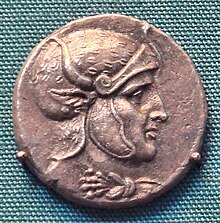
Coin of
Seleucus I Nicator
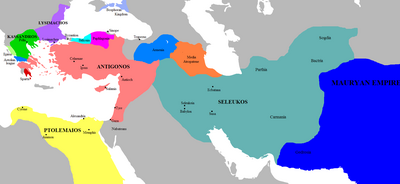
The Kingdoms of the
Diadochi
circa 303 BC
Alexander’s generals (the
Diadochi
) jostled for supremacy over parts of
his empire.
Ptolemy
, a former general and the satrap of
Egypt
, was the first to challenge the new
system; this led to the demise of Perdiccas. Ptolemy’s revolt led to a new
subdivision of the empire with the
Partition of Triparadisus
in 320 BC.
Seleucus
, who had been “Commander-in-Chief of
the camp” under Perdiccas since 323 BC but helped to assassinate him later,
received Babylonia
and, from that point, continued to
expand his dominions ruthlessly. Seleucus established himself in
Babylon
in 312 BC, the year used as the
foundation date of the Seleucid Empire. He ruled not only Babylonia, but the
entire enormous eastern part of Alexander’s empire:
“Always lying in wait for the neighboring nations, strong in arms and
persuasive in council, he [Seleucus] acquired Mesopotamia, Armenia,
‘Seleucid’ Cappadocia, Persis, Parthia, Bactria, Arabia, Tapouria, Sogdia,
Arachosia, Hyrcania, and other adjacent peoples that had been subdued by
Alexander, as far as the river Indus, so that the boundaries of his empire
were the most extensive in Asia after that of Alexander. The whole region
from Phrygia to the Indus was subject to Seleucus.”
— Appian
, The Syrian Wars
Seleucus
went as far as
India
, where, after
two years of war
, he reached an agreement with
Chandragupta Maurya
, in which he exchanged his
eastern territories for a considerable force of 500
war elephants
, which would play a decisive role
at
Ipsus
(301 BC).
“The Indians occupy [in part] some of the countries situated along the
Indus, which formerly belonged to the Persians: Alexander deprived the
Ariani of them, and established there settlements of his own. But
Seleucus Nicator
gave them to
Sandrocottus
in consequence of a marriage
contract, and received in return five hundred elephants.”
—Strabo, Geographica
Westward expansion
Following his and
Lysimachus
‘ victory over
Antigonus Monophthalmus
at the decisive
Battle of Ipsus
in 301 BC, Seleucus took
control over eastern
Anatolia
and northern
Syria
.
In the latter area, he founded a new capital at
Antioch on the Orontes
, a city he named after
his father. An alternative capital was established at
Seleucia on the Tigris
, north of Babylon.
Seleucus’s empire reached its greatest extent following his defeat of his
erstwhile ally, Lysimachus, at
Corupedion
in 281 BC, after which Seleucus
expanded his control to encompass western Anatolia. He hoped further to take
control of Lysimachus’s lands in Europe – primarily
Thrace
and even
Macedonia
itself, but was assassinated by
Ptolemy Ceraunus
on landing in Europe.
His son and successor,
Antiochus I Soter
, was left with an enormous
realm consisting of nearly all of the Asian portions of the Empire, but faced
with
Antigonus II Gonatas
in Macedonia and
Ptolemy II Philadelphus
in
Egypt
, he proved unable to pick up where his
father had left off in conquering the European portions of Alexander’s empire.
An overextended domain
Nevertheless, even before Seleucus’ death, it was difficult to assert control
over the vast eastern domains of the Seleucids. Seleucus invaded
Punjab region
region of
India
in 305 BC,
confronting
Chandragupta Maurya
(Sandrokottos),
founder of the
Maurya empire
. It is said that Chandragupta
fielded an army of 600,000 men and 9,000 war elephants (Pliny, Natural
History VI, 22.4).
Mainstream scholarship asserts that Chandragupta received vast territory,
sealed in a treaty, west of the Indus, including the
Hindu Kush
, modern day
Afghanistan
, and the
Balochistan
province of
Pakistan
. Archaeologically, concrete
indications of Mauryan rule, such as the inscriptions of the
Edicts of Ashoka
, are known as far as
Kandahar
in southern Afghanistan.
It is generally thought that Chandragupta married
Seleucus’s
daughter, or a
Macedonian
princess
, a gift from Seleucus to formalize an
alliance. In a return gesture, Chandragupta sent 500
war–elephants,
a military asset which would play a decisive role at the
Battle of Ipsus
in 301 BC. In addition to this
treaty, Seleucus dispatched an ambassador,
Megasthenes
, to Chandragupta, and later
Deimakos
to his son
Bindusara
, at the Mauryan court at
Pataliputra
(modern
Patna
in
Bihar state
). Megasthenes wrote detailed
descriptions of India and Chandragupta’s reign, which have been partly preserved
to us through
Diodorus Siculus
. Later
Ptolemy II Philadelphus
, the ruler of
Ptolemaic Egypt
and contemporary of
Ashoka the Great
, is also recorded by
Pliny the Elder
as having sent an ambassador
named
Dionysius
to the Mauryan court.
Other territories lost before Seleucus’ death were
Gedrosia
in the south-east of the Iranian
plateau, and, to the north of this,
Arachosia
on the west bank of the
Indus River
.
Antiochus I (reigned 281–261 BC) and his son and successor
Antiochus II Theos
(reigned 261–246 BC) were
faced with challenges in the west, including repeated wars with
Ptolemy II
and a
Celtic
invasion of Asia Minor — distracting
attention from holding the eastern portions of the Empire together. Towards the
end of Antiochus II’s reign, various provinces simultaneously asserted their
independence, such as
Bactria
under
Diodotus
,
Parthia
under
Arsaces
, and
Cappadocia
under
Ariarathes III
.

In Bactria
, the satrap
Diodotus
asserted independence to
form the
Greco-Bactrian kingdom
c.245 BC.
Diodotus
, governor for the
Bactrian
territory, asserted independence in
around 245 BC, although the exact date is far from certain, to form the
Greco-Bactrian
kingdom. This kingdom was
characterized by a rich
Hellenistic
culture, and was to continue its
domination of Bactria until around 125 BC, when it was overrun by the invasion
of northern nomads. One of the Greco-Bactrian kings,
Demetrius I of Bactria
, invaded India around
180 BC to form the
Greco-Indian
kingdom, lasting until around AD
20.
The Seleucid satrap of Parthia, named
Andragoras
, first claimed independence, in a
parallel to the secession of his Bactrian neighbour. Soon after however, a
Parthian tribal chief called
Arsaces
invaded the Parthian
territory around 238 BC to
form the
Arsacid Dynasty
— the starting point of the
powerful
Parthian Empire
.
By the time Antiochus II’s son
Seleucus II Callinicus
came to the throne
around 246 BC, the Seleucids seemed to be at a low ebb indeed. Seleucus II was
soon dramatically defeated in the
Third Syrian War
against
Ptolemy III of Egypt
and then had to fight a
civil war against his own brother
Antiochus Hierax
. Taking advantage of this
distraction, Bactria and Parthia seceded from the empire. In Asia Minor too, the
Seleucid dynasty seemed to be losing control — Gauls had fully established
themselves in Galatia
, semi-independent semi-Hellenized
kingdoms had sprung up in
Bithynia
,
Pontus
, and
Cappadocia
, and the city of
Pergamum
in the west was asserting its
independence under the
Attalid Dynasty
.
Revival
(223–191 BC)

Silver coin of
Antiochus III the Great
.
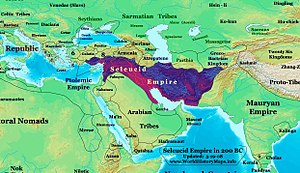
The Seleucid Empire in 200 BC (before expansion into
Anatolia
and
Greece
).
A revival would begin when Seleucus II’s younger son,
Antiochus III the Great
, took the throne in 223
BC. Although initially unsuccessful in the
Fourth Syrian War
against Egypt, which led to a
defeat at the
Battle of Raphia
(217 BC), Antiochus would
prove himself to be the greatest of the Seleucid rulers after Seleucus I
himself. He spent the next ten years on his
anabasis
through the eastern parts of his
domain and restoring rebellious vassals like Parthia and
Greco-Bactria
to at least nominal obedience. He
won the
Battle of the Arius
and
besieged the Bactrian capital
, and even
emulated Alexander with an expedition into India where he met with king
Sophagasenus
receiving war elephants:
“He (Antiochus) crossed the Caucasus and descended into India; renewed
his friendship with Sophagasenus the king of the Indians; received more
elephants, until he had a hundred and fifty altogether; and having once more
provisioned his troops, set out again personally with his army: leaving
Androsthenes of Cyzicus the duty of taking home the treasure which this king
had agreed to hand over to him”. Polybius 11.39
When he returned to the west in 205 BC, Antiochus found that with the death
of
Ptolemy IV
, the situation now looked propitious
for another western campaign. Antiochus and
Philip V of Macedon
then made a pact to divide
the Ptolemaic possessions outside of Egypt, and in the
Fifth Syrian War
, the Seleucids ousted
Ptolemy V
from control of
Coele-Syria
. The
Battle of Panium
(198 BC) definitively
transferred these holdings from the Ptolemies to the Seleucids. Antiochus
appeared, at the least, to have restored the Seleucid Kingdom to glory.
Expansion into Greece and War with Rome
Following his erstwhile ally
Philip’s
defeat by Rome in 197 BC, Antiochus
saw the opportunity for expansion into Greece itself. Encouraged by the exiled
Carthaginian
general
Hannibal
, and making an alliance with the
disgruntled
Aetolian League
, Antiochus launched an invasion
across the
Hellespont
. With his huge army he was intent
upon establishing the Seleucid empire as the foremost power in the Hellenic
world but these plans put the empire on a collision course with the new
superpower of the Mediterranean, the
Roman Republic
. At the battles of
Thermopylae
and
Magnesia
, Antiochus’s forces were resoundingly
defeated and he was compelled to make peace and sign the
Treaty of Apamea
in (188 BC), the main clause
of which saw the Seleucids agree to pay a large indemnity, retreat from
Anatolia
and to never again attempt to expand
Seleucid territory west of the
Taurus Mountains
. The
Kingdom of Pergamum
and the
Republic of Rhodes
, Rome’s allies in the war,
were given the former Seleucid lands in Anatolia. Antiochus died in 187 BC on
another expedition to the east, where he sought to extract money to pay the
indemnity.
Roman power,
Parthia and Judea
The reign of his son and successor
Seleucus IV Philopator
(187-175 BC) was largely
spent in attempts to pay the large indemnity, and Seleucus was ultimately
assassinated by his minister
Heliodorus
.
Seleucus’ younger brother,
Antiochus IV Epiphanes
, now seized the throne.
He attempted to restore Seleucid power and prestige with a successful war
against the old enemy,
Ptolemaic Egypt
, which met with initial success
as the Seleucids defeated and drove the Egyptian army back to
Alexandria
itself. As the king planned on how
to conclude the war, he was informed that Roman commissioners, led by the
Proconsul
Gaius Popillius Laenas
, were near and
requesting a meeting with the Seleucid king. Antiochus agreed, but when they met
and Antiochus held out his hand in friendship, Popilius placed in his hand the
tablets on which was written the decree of the senate and telling him to read
it. When the king said that he would call his friends into council and consider
what he ought to do, Popilius drew a circle in the sand around the king’s feet
with the stick he was carrying and said, “Before you step out of that circle
give me a reply to lay before the senate.” For a few moments he hesitated,
astounded at such a peremptory order, and at last replied, “I will do what the
senate thinks right.” He then chose to withdraw rather than set the empire to
war with Rome again.
The latter part of his reign saw a further disintegration of the Empire
despite his best efforts. Weakened economically, militarily and by loss of
prestige, the Empire became vulnerable to rebels in the eastern areas of the
empire, who began to further undermine the empire while the Parthians moved into
the power vacuum to take over the old Persian lands. Antiochus’ aggressive
Hellenizing (or de-Judaizing) activities provoked a full scale armed rebellion
in Judea
—the
Maccabean Revolt
. Efforts to deal with both the
Parthians and the Jews as well as retain control of the provinces at the same
time proved beyond the weakened empire’s power. Antiochus died during a military
expedition against the Parthians in 164 BC.
Civil war and
further decay

Coin of
Antiochus IV Epiphanes
.

Silver coin of
Alexander Balas
.
After the death of
Antiochus IV Epiphanes
, the Seleucid Empire
became increasingly unstable. Frequent civil wars made central authority tenuous
at best. Epiphanes’ young son,
Antiochus V Eupator
, was first overthrown by
Seleucus IV’s son,
Demetrius I Soter
in 161 BC. Demetrius I
attempted to restore Seleucid power in
Judea
particularly, but was overthrown in 150
BC by
Alexander Balas
— an impostor who (with
Egyptian backing) claimed to be the son of Epiphanes. Alexander Balas reigned
until 145 BC, when he was overthrown by Demetrius I’s son,
Demetrius II Nicator
. Demetrius II proved
unable to control the whole of the kingdom, however. While he ruled
Babylonia
and eastern
Syria
from
Damascus
, the remnants of Balas’ supporters —
first supporting Balas’ son
Antiochus VI
, then the usurping general
Diodotus Tryphon
— held out in
Antioch
.
Meanwhile, the decay of the Empire’s territorial possessions continued apace.
By 143 BC, the
Jews
in form of the
Maccabees
had fully established their
independence.
Parthian
expansion continued as well. In 139
BC, Demetrius II was defeated in battle by the Parthians and was captured. By
this time, the entire Iranian Plateau had been lost to Parthian control.
Demetrius Nicator’s brother,
Antiochus VII Sidetes
, took the throne after
his brother’s capture. He faced the enormous task of restoring a rapidly
crumbling empire; one facing threats on multiple fronts. Hard-won control of
Coele-Syria
was threatened by the Jewish
Maccabee rebels. Once-vassal dynasties in Armenia, Cappadocia, and Pontus were
threatening Syria and northern
Mesopotamia
; the nomadic Parthians, brilliantly
led by
Mithridates I of Parthia
had overrun uppland
Media (home of the famed
Nisean horse
herd); and Roman intervention was
an ever-present threat. Sidetes managed to bring the Maccabees to heel; frighten
the Anatolian dynasts into a temporary submission; and then, in 133, turned east
with the full might of the Royal Army (supported by a body of Jews under the
Maccabee prince, John Hyrcanus) to drive back the Parthians.
Sidetes’ campaign initially met with spectacular success, recapturing
Mesopotamia, Babylonia and Media; defeating and slaying the Parthian Satrap of
Seleucia-on-Tigris
in personal combat. In the
winter of 130/129 BC, his army was scattered in winter quarters throughout Media
and Persis when the Parthian king,
Phraates II
, counter-attacked. Moving to
intercept the Parthians with only the troops at his immediate disposal, he was
ambushed and killed. Antiochus Sidetes is sometimes called the last great
Seleucid king.
After the death of Antiochus VII Sidetes, all of the recovered eastern
territories were recaptured by the Parthians. The Maccabees again rebelled,
civil war soon tore the empire to pieces, and the Armenians began to encroach on
Syria from the north.
Collapse
(100–63 BC)
By 100 BC, the once formidable Seleucid Empire encompassed little more than
Antioch
and some Syrian cities. Despite the
clear collapse of their power, and the decline of their kingdom around them,
nobles continued to play kingmakers on a regular basis, with occasional
intervention from
Ptolemaic Egypt
and other outside powers. The
Seleucids existed solely because no other nation wished to absorb them — seeing
as they constituted a useful buffer between their other neighbours. In the wars
in Anatolia between
Mithridates VI
of
Pontus
and
Sulla
of Rome, the Seleucids were largely left
alone by both major combatants.
Mithridates’ ambitious son-in-law,
Tigranes the Great
, king of
Armenia
, however, saw opportunity for expansion
in the constant civil strife to the south. In 83 BC, at the invitation of one of
the factions in the interminable civil wars, he invaded Syria, and soon
established himself as ruler of Syria, putting the Seleucid Empire virtually at
an end.
Seleucid rule was not entirely over, however. Following the Roman general
Lucullus
‘ defeat of both Mithridates and
Tigranes in 69 BC, a rump Seleucid kingdom was restored under
Antiochus XIII
. Even so, civil wars could not
be prevented, as another Seleucid,
Philip II
, contested rule with Antiochus. After
the Roman conquest of Pontus, the Romans became increasingly alarmed at the
constant source of instability in Syria under the Seleucids. Once Mithridates
was defeated by Pompey
in 63 BC, Pompey set about the task of
remaking the Hellenistic East, by creating new client kingdoms and establishing
provinces. While client nations like
Armenia
and
Judea
were allowed to continue with some degree
of autonomy under local kings, Pompey saw the Seleucids as too troublesome to
continue; and doing away with both rival Seleucid princes, he made Syria into a
Roman province.
Culture
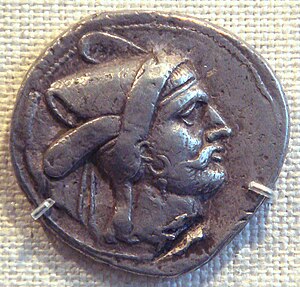
Bagadates I
(Minted 290–280 BC) was
the first indigenous Seleucid satrap to be appointed.
The Seleucid empire’s geographic span, from the
Aegean Sea
to what is now
Afghanistan
and
Pakistan
, created a melting pot of various
peoples, such as Greeks
,
Armenians
,
Persians
,
Medes
,
Assyrians
, and
Jews
. The immense size of the empire, followed
by its encompassing nature, made the Seleucid rulers have a governing interest
in implementing a policy of racial unity initiated by Alexander.
The
Hellenization
of the Seleucid empire was
achieved by the establishment of Greek cities throughout the empire.
Historically significant towns and cities, such as
Antioch
, were created or renamed with more
appropriate
Greek
names. The creation of new
Greek
cities and towns was aided by the fact
that the Greek mainland was overpopulated and therefore made the vast Seleucid
empire ripe for colonization. Colonization was used to further Greek interest
while facilitating the assimilation of many native groups. Socially, this led to
the adoption of Greek practices and customs by the educated native classes in
order to further themselves in public life and the ruling
Macedonian
class gradually adopted some of the
local traditions. By 313 BC, Hellenic ideas had begun their almost 250-year
expansion into the Near East, Middle East, and Central Asian cultures. It was
the empire’s governmental framework to rule by establishing hundreds of cities
for trade and occupational purposes. Many of the existing cities began — or were
compelled by force — to adopt Hellenized philosophic thought, religious
sentiments, and politics.
Synthesizing Hellenic and indigenous cultural, religious, and philosophical
ideas met with varying degrees of success — resulting in times of simultaneous
peace and rebellion in various parts of the empire. Such was the case with the
Jewish population of the Seleucid empire because the Jews posed a significant
problem which eventually led to war. Contrary to the accepting nature of the
Ptolemaic
empire towards native religions and
customs, the Seleucids gradually tried to force Hellenization upon the Jewish
people in their territory by outlawing Judaism. This eventually led to the
revolt of the Jews
under Seleucid control,
which would later lead to the Jews achieving independence.
Seleucid rulers

Seleucus I Nicator
, the founder of
the Seleucid Empire.
The Seleucid dynasty or the Seleucidae (from
Greek
: Σελευκίδαι,
Seleukídai) was a
Greek
Macedonian
descendants of
Seleucus I Nicator
(“the Victor”), who ruled
the
Seleucid Kingdom
centered in the
Near East
and regions of the
Asian part of the earlier
Achaemenid
Persian Empire
during the
Hellenistic period
.
List
Seleucid Rulers
| King |
Reign (BCE) |
Consort(s) |
Comments |
|
Seleucus I Nicator
|
Satrap
311-305
King 305-281 |
Apama
|
|
|
Antiochus I Soter
|
co-ruler from 291, ruled 281-261 |
Stratonice of Syria
|
Co-ruler with his father for 10 years |
|
Antiochus II Theos
|
261-246 |
Laodice I
Berenice
|
Berenice was a daughter of
Ptolemy II
of Egypt. Laodice I had her
and her son murdered. |
|
Seleucus II Callinicus
|
246-225 |
Laodice II
|
|
Seleucus III Ceraunus
(or Soter) |
225-223 |
|
Seleucus III was assassinated by members of his army. |
|
Antiochus III the Great
|
223-187 |
Laodice III
Euboea of Chalcis |
Antiochus III was a brother of Seleucus III |
|
Seleucus IV Philopator
|
187-175 |
Laodice IV
|
This was a brother-sister marriage. |
|
Antiochus IV Epiphanes
|
175-163 |
Laodice IV
|
|
|
Antiochus V Eupator
|
163-161 |
|
|
|
Demetrius I Soter
|
161-150 |
Apama ?
Laodice V
? |
Son of Seleucus IV Philopator and Laodice IV |
|
Alexander I Balas
|
150-145 |
Cleopatra Thea
|
Son of Antiochus IV and
Laodice IV
|
|
Demetrius II Nicator
|
first reign, 145-138 |
Cleopatra Thea
|
Son of Demetrius I |
Antiochus VI Dionysus
(or Epiphanes) |
145-140? |
|
Son of Alexander Balas and Cleopatra Thea |
|
Diodotus Tryphon
|
140-138 |
|
General who was a regent for Antiochus VI Dionysus. Took the throne
after murdering his charge. |
Antiochus VII Sidetes
(or Euergetes) |
138-129 |
Cleopatra Thea
|
Son of Demetrius I |
|
Demetrius II Nicator
|
second reign, 129-126 |
Cleopatra Thea
|
Demetrius was murdered at the instigation of his wife Cleopatra
Thea. |
|
Alexander II Zabinas
|
129-123 |
|
Counter-king who claimed to be an adoptive son of Antiochus VII
Sidetes |
|
Cleopatra Thea
|
126-123 |
|
Daughter of Ptolemy VI of Egypt. Married to three kings: Alexander
Balas, Demetrius II Nicator, and Antiochus VII Sidetes. Mother of
Antiochus VI, Seleucus V, Antiochus VIII Grypus, and Antiochus IX
Cyzicenus. Coregent with her son Antiochus VIII Grypus. |
|
Seleucus V Philometor
|
126/125 |
|
Murdered by his mother Cleopatra Thea |
|
Antiochus VIII Grypus
|
125-96 |
Tryphaena
of Egypt
Cleopatra Selene I
of Egypt |
|
|
Antiochus IX Cyzicenus
|
114-96 |
Cleopatra IV of Egypt
Cleopatra Selene I
of Egypt |
|
Seleucus VI Epiphanes
Nicator |
96-95 |
|
|
Antiochus X Eusebes
Philopator |
95-92 or 83 |
Cleopatra Selene I
|
|
Demetrius III Eucaerus
(or Philopator) |
95-87 |
|
|
Antiochus XI Epiphanes
Philadelphus |
95-92 |
|
|
|
Philip I Philadelphus
|
95-84/83 |
|
|
|
Antiochus XII Dionysus
|
87-84 |
|
|
(Tigranes
I of Armenia) |
83-69 |
|
|
Seleucus VII Kybiosaktes
or Philometor |
83-69 |
|
|
|
Antiochus XIII Asiaticus
|
69-64 |
|
|
|
Philip II Philoromaeus
|
65-63 |
|
|
Family tree
|
|
|
|
|
|
|
|
|
|
|
|
Antiochus |
|
Laodice |
|
|
|
|
|
|
|
|
|
|
|
|
|
|
|
|
|
|
|
|
|
|
|
|
|
|
|
|
|
|
|
|
|
| |
|
|
|
|
|
|
|
|
|
|
|
|
|
|
Seleucus I Nicator
Kg. 305–281 |
|
Apama
|
|
|
|
|
|
|
|
|
|
|
|
|
|
|
|
|
|
|
|
|
|
|
|
|
|
|
|
|
|
|
|
| |
|
|
|
|
|
|
|
Achaeus |
|
|
Stratonice
|
|
Antiochus I Soter
Kg. 281–261 |
|
|
|
|
|
|
|
|
|
|
|
|
|
|
|
|
|
|
|
|
|
|
|
|
|
|
|
|
|
|
|
|
|
|
| |
|
|
|
|
|
|
|
Andromachus
|
|
|
|
|
Antiochus II Theos
Kg. 261–246 |
|
Laodice I
|
|
|
|
|
|
|
|
|
|
|
|
|
|
|
|
|
|
|
|
|
|
|
|
|
|
|
|
|
|
|
|
|
|
|
|
|
|
|
|
|
|
|
|
|
|
|
|
|
|
|
|
|
|
|
|
Achaeus
Kg. 220–213 |
|
|
Laodice II
|
|
Seleucus II Callinicus
Kg. 246–226 |
|
Antiochus Hierax
Kg. 240–228 |
|
|
|
|
|
|
|
|
|
|
|
|
|
|
|
|
|
|
|
|
|
|
|
|
|
|
|
|
|
|
|
|
|
|
|
|
|
|
|
|
|
|
|
|
|
|
|
|
|
|
Seleucus III Ceraunus
Kg. 226–223 |
|
Antiochus III the Great
Kg. 223–187 |
|
Laodice III
|
|
|
|
|
|
|
|
|
|
|
|
|
|
|
|
|
|
|
|
|
|
|
|
|
|
|
|
|
|
|
|
|
|
|
|
|
|
|
|
|
|
|
|
|
|
|
|
|
|
|
|
|
|
|
Seleucus IV Philopator
Kg. 187–175 |
|
Laodice |
|
Antiochus IV Epiphanes
Kg. 175–163 |
|
|
|
|
|
|
|
|
|
|
|
|
|
|
|
|
|
|
|
|
|
|
|
|
|
|
|
|
|
|
|
|
|
|
|
| |
|
|
|
|
|
|
|
Apama |
|
Demetrius I Soter
Kg. 161–150 |
|
Antiochus V Eupator
Kg. 163–161 |
|
|
|
|
|
|
|
|
|
|
|
|
|
|
|
|
|
|
|
|
|
|
|
|
|
|
|
|
|
|
|
|
|
|
|
|
|
|
|
|
|
|
|
|
|
|
|
|
|
Alexander I Balas
Kg. 150–146 |
|
Cleopatra Thea
|
|
Demetrius II Nicator
Kg. 145–125 |
|
|
|
|
|
|
|
|
|
Antiochus VII Sidetes
Kg. 138–129 |
|
|
|
|
|
|
|
|
|
|
|
|
|
|
|
|
|
|
|
|
|
|
|
|
|
|
|
|
|
|
|
|
|
|
|
|
|
|
|
|
|
|
Antiochus VI Dionysus
Kg. 144–142 |
|
Seleucus V Philometor
Kg. 126–125 |
|
Antiochus VIII Grypus
Kg. 125–96 |
|
Cleopatra |
|
|
|
Antiochus IX Cyzicenus
Kg. 116–96 |
|
|
|
|
|
|
|
|
|
|
|
|
|
|
|
|
|
|
|
|
|
|
|
|
|
|
|
|
|
|
|
|
|
|
|
|
|
|
|
|
|
|
|
|
|
|
|
|
|
|
|
|
|
Seleucus VI Epiphanes
Kg. 96–95 |
|
Antiochus XI Epiphanes
Kg. 95–92 |
|
Philip I Philadelphus
Kg. 95–83 |
|
Demetrius III Eucaerus
Kg. 95–88 |
|
Antiochus XII Dionysus
Kg. 87–84 |
|
Antiochus X Eusebes
Kg. 95–83 |
| |
|
|
|
|
|
|
|
|
|
|
|
|
|
|
|
|
|
|
|
|
|
|
|
|
|
|
| |
|
|
|
|
|
|
|
|
|
Philip II Philoromaeus
Kg. 69–63 |
|
|
|
|
|
|
|
|
|
Antiochus XIII Asiaticus
Kg. 69–64 |
|






![Eros1st c. BCE marble from Pompeii. This statue is also known as Eros Centocelle, and is thought to be a copy of the colossal Eros of Thespiae, a work by Praxiteles.[1]](https://upload.wikimedia.org/wikipedia/commons/thumb/c/c3/Eros_Farnese_MAN_Napoli_6353.jpg/150px-Eros_Farnese_MAN_Napoli_6353.jpg) Antiochus
Antiochus












